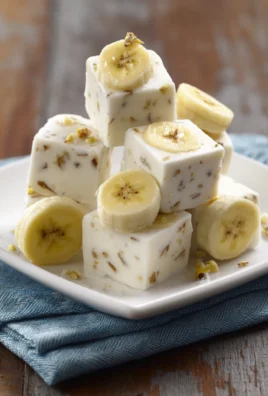Vietnamese Rice Paper Rolls, also known as G?i cu?n, are a vibrant and refreshing culinary delight that I absolutely adore! Imagine biting into a translucent roll bursting with fresh herbs, tender vermicelli noodles, succulent shrimp, and crisp vegetables all perfectly complemented by a flavorful dipping sauce. Trust me, it’s an explosion of textures and tastes that will leave you craving more.
These delightful rolls have a rich history rooted in Vietnamese cuisine, often enjoyed as a light and healthy appetizer or a satisfying lunch. They represent the essence of Vietnamese cooking: fresh, balanced, and visually appealing. The beauty of Vietnamese Rice Paper Rolls lies not only in their taste but also in their versatility. You can customize the fillings to your liking, making them a perfect option for vegetarians, vegans, and meat-lovers alike.
What makes these rolls so universally loved? Well, besides their incredible flavor profile, they are incredibly easy to prepare and require no cooking! This makes them a fantastic option for busy weeknights or when you want a light and refreshing meal without spending hours in the kitchen. The combination of the delicate rice paper, the satisfying crunch of the vegetables, and the savory protein creates a symphony of textures that is simply irresistible. Plus, they are naturally gluten-free and low in calories, making them a guilt-free indulgence. So, are you ready to embark on a culinary adventure and create your own batch of these amazing rolls? Let’s get started!
Ingredients:
- Rice Paper Wrappers: 20-30 sheets, depending on size and desired quantity. Look for the round, thin rice paper wrappers specifically made for spring rolls.
- Cooked Shrimp: 1 pound, peeled, deveined, and cooked. You can either boil, steam, or pan-fry the shrimp. I prefer steaming for a tender texture.
- Rice Vermicelli Noodles: 4 ounces, cooked according to package directions. Be careful not to overcook them, as they can become mushy. Rinse with cold water after cooking to stop the cooking process and prevent sticking.
- Fresh Mint: 1 cup, loosely packed fresh mint leaves.
- Fresh Cilantro: 1 cup, loosely packed fresh cilantro leaves.
- Fresh Basil: 1 cup, loosely packed fresh basil leaves (Thai basil is ideal, but regular basil works too).
- Lettuce: 1 head of butter lettuce or romaine lettuce, washed and separated into leaves.
- Carrots: 1 large carrot, julienned or shredded.
- Cucumber: 1 medium cucumber, julienned or thinly sliced. Seed it first to prevent the rolls from becoming too watery.
- Bean Sprouts: 1 cup, rinsed.
- Peanut Sauce Ingredients:
- Peanut Butter: ½ cup creamy peanut butter.
- Hoisin Sauce: 2 tablespoons.
- Rice Vinegar: 2 tablespoons.
- Soy Sauce: 1 tablespoon.
- Honey or Maple Syrup: 1 tablespoon (for sweetness).
- Sesame Oil: 1 teaspoon.
- Garlic: 1 clove, minced.
- Ginger: ½ teaspoon, grated.
- Hot Sauce (Sriracha or Chili Garlic Sauce): To taste (optional, for a little kick!).
- Water: As needed to thin the sauce to your desired consistency.
Preparing the Ingredients:
- Cook the Shrimp: If you haven’t already, cook your shrimp. I like to steam them for about 3-5 minutes, until they turn pink and opaque. Avoid overcooking, or they’ll become rubbery. Once cooked, let them cool slightly before using.
- Cook the Rice Vermicelli Noodles: Cook the rice vermicelli according to the package directions. Usually, this involves boiling them for a few minutes until they are tender but not mushy. Immediately rinse them under cold water to stop the cooking process and prevent them from sticking together. Drain well.
- Prepare the Vegetables: Wash and thoroughly dry all your vegetables. Julienne or shred the carrots and cucumber. Make sure the lettuce leaves are clean and dry. Having everything prepped and ready to go will make the rolling process much smoother.
- Prepare the Herbs: Wash and dry the mint, cilantro, and basil. Gently remove the leaves from the stems.
- Make the Peanut Sauce: In a medium bowl, whisk together the peanut butter, hoisin sauce, rice vinegar, soy sauce, honey (or maple syrup), sesame oil, minced garlic, and grated ginger. Add hot sauce to taste, if desired. Gradually add water, a tablespoon at a time, whisking until the sauce reaches your desired consistency. It should be thick enough to cling to the rolls but thin enough to dip easily. Taste and adjust the seasonings as needed. You might want to add a little more honey for sweetness or a little more rice vinegar for tanginess.
Rolling the Rice Paper Rolls:
- Prepare Your Workspace: You’ll need a clean, flat surface to work on. A large cutting board or a clean countertop works well. Have a shallow dish or pie plate filled with warm water nearby. This is what you’ll use to soften the rice paper wrappers.
- Soften the Rice Paper: Dip one rice paper wrapper into the warm water for a few seconds, until it becomes pliable but not too soft. Be careful not to over-soak it, as it will become sticky and difficult to work with. The rice paper will continue to soften as you work with it.
- Lay the Rice Paper Flat: Carefully remove the softened rice paper from the water and lay it flat on your prepared surface.
- Add the Fillings: Arrange your fillings in the center of the rice paper wrapper, leaving about an inch or two of space on each side. Start with a layer of lettuce, then add some rice vermicelli noodles, carrots, cucumber, bean sprouts, and herbs (mint, cilantro, and basil). Place the shrimp on top, arranging them attractively. I like to place them with the curved side facing down so they look nice when the roll is finished. Don’t overfill the wrapper, or it will be difficult to roll and may tear.
- Roll the Rice Paper: Fold the sides of the rice paper wrapper inward, over the fillings. Then, starting from the bottom edge closest to you, tightly roll the wrapper up and over the fillings, like you’re rolling a burrito. Keep the roll tight and compact as you go.
- Repeat: Repeat steps 2-5 with the remaining rice paper wrappers and fillings.
- Serve Immediately or Store: Serve the rice paper rolls immediately with the peanut sauce for dipping. If you’re not serving them right away, you can store them in the refrigerator for a few hours. To prevent them from sticking together, wrap each roll individually in plastic wrap or place them in a single layer in an airtight container with a damp paper towel on top.
Tips and Variations:
- Don’t Overfill: It’s tempting to pack as much filling as possible into each roll, but resist the urge! Overfilling will make the rolls difficult to roll and more likely to tear.
- Use Warm Water: The water should be warm, not hot. Hot water can make the rice paper too sticky and difficult to handle.
- Work Quickly: Once the rice paper is softened, it’s best to work quickly, as it will continue to soften and become more delicate.
- Keep Your Hands Wet: Keeping your hands slightly damp will prevent the rice paper from sticking to them.
- Experiment with Fillings: Feel free to get creative with your fillings! You can add other vegetables like bell peppers, avocado, or shredded cabbage. You can also substitute the shrimp with other proteins like grilled chicken, pork, or tofu.
- Make it Vegetarian or Vegan: To make vegetarian rice paper rolls, simply omit the shrimp and use tofu or extra vegetables instead. To make them vegan, make sure your peanut sauce is also vegan by using maple syrup or agave nectar instead of honey.
- Add a Kick: If you like a little heat, add a pinch of red pepper flakes or a drizzle of sriracha to the fillings.
- Dipping Sauce Variations: While peanut sauce is the most common dipping sauce for rice paper rolls, you can also try other sauces like nuoc cham (Vietnamese dipping sauce), sweet chili sauce, or even a simple soy sauce and sesame oil mixture.
- Prepare Ahead: You can prepare the fillings and the peanut sauce ahead of time. Store them separately in the refrigerator until you’re ready to assemble the rolls. This is a great way to save time when you’re entertaining.
- Prevent Sticking: To prevent the rolls from sticking together, you can lightly brush them with sesame oil before storing them.
Troubleshooting Rice Paper Rolls:
- Rice Paper Tears: If the rice paper tears, it’s usually because it’s either over-soaked or overfilled. Try using less water and less filling. You can also try using two layers of rice paper for extra strength.
- Rolls are Too Sticky: If the rolls are too sticky, it’s usually because the rice paper is over-soaked. Try using less water and working more quickly.
- Rolls are Too Dry: If the rolls are too dry, it’s usually because the rice paper wasn’t soaked enough. Try soaking it for a few seconds longer.
- Rolls are Falling Apart: If the rolls are falling apart, it’s usually because they weren’t rolled tightly enough. Make sure to roll them tightly and compactly.
Enjoying Your Homemade Rice Paper Rolls:
Making Vietnamese rice paper rolls is a fun and rewarding experience. They’re a healthy, delicious, and versatile dish that’s perfect for a light lunch, appetizer, or snack. Don’t be intimidated by the rolling process with a little practice, you’ll be making perfect rice paper rolls in no time! And

Conclusion:
This isn’t just another recipe; it’s an invitation to experience the vibrant flavors and textures of authentic Vietnamese cuisine right in your own kitchen. These Vietnamese Rice Paper Rolls are a must-try because they’re incredibly fresh, customizable to your liking, and surprisingly easy to make once you get the hang of it. Forget ordering takeout you can create a healthier, tastier, and more satisfying version at home!
What makes these rolls so special? It’s the perfect balance of crisp vegetables, tender protein (or tofu!), fragrant herbs, and the delicate chewiness of the rice paper. Each bite is an explosion of flavor that will leave you wanting more. Plus, they’re naturally gluten-free and can easily be adapted to be vegetarian or vegan, making them a crowd-pleaser for any gathering.
But the real beauty of this recipe lies in its versatility. Feel free to experiment with different fillings! Try adding grilled shrimp, shredded chicken, or even thinly sliced pork. For a vegetarian option, consider using marinated tofu, sautéed mushrooms, or extra avocado. Don’t be afraid to get creative with your vegetables too. Bean sprouts, shredded carrots, cucumber, lettuce, and mint are all classic choices, but you could also add bell peppers, shredded cabbage, or even some pickled vegetables for an extra zing.
And let’s not forget about the dipping sauce! While the peanut sauce is a classic accompaniment, you can also try a sweet chili sauce, a hoisin-based sauce, or even a simple mixture of soy sauce, rice vinegar, and sesame oil. Each sauce will bring a different dimension to the rolls, so experiment and find your favorite combination.
Serving Suggestions: These Vietnamese Rice Paper Rolls are perfect as a light lunch, a refreshing appetizer, or even a healthy snack. They’re also a great option for parties and potlucks, as they can be made ahead of time and are always a hit with guests. To prevent the rolls from sticking together, wrap each one individually in plastic wrap or arrange them on a platter with a damp paper towel covering them.
Variations: Want to add a little heat? Try adding a pinch of chili flakes to your dipping sauce or including some thinly sliced jalapeños in your rolls. For a richer flavor, consider adding some toasted sesame seeds or chopped peanuts to your fillings. And if you’re feeling adventurous, you could even try making your own rice paper from scratch!
I truly believe that this recipe for Vietnamese Rice Paper Rolls will become a staple in your kitchen. It’s a fun and interactive way to enjoy a healthy and delicious meal, and it’s a great way to impress your friends and family.
So, what are you waiting for? Gather your ingredients, roll up your sleeves, and get ready to experience the magic of Vietnamese cuisine. I’m confident that you’ll love these rolls as much as I do.
And most importantly, I’d love to hear about your experience! Once you’ve tried this recipe, please share your photos and comments below. Let me know what variations you tried, what dipping sauce you preferred, and any tips or tricks you discovered along the way. Your feedback is invaluable and helps me to continue creating delicious and accessible recipes for everyone to enjoy. Happy rolling!
Vietnamese Rice Paper Rolls: A Delicious & Healthy Recipe
Fresh and flavorful Vietnamese rice paper rolls filled with shrimp, vermicelli noodles, crisp vegetables, and fragrant herbs, served with a creamy peanut dipping sauce.
Ingredients
- 20-30 Rice Paper Wrappers (round, thin)
- 1 pound Cooked Shrimp (peeled, deveined, cooked)
- 4 ounces Rice Vermicelli Noodles (cooked, rinsed)
- 1 cup Fresh Mint (loosely packed leaves)
- 1 cup Fresh Cilantro (loosely packed leaves)
- 1 cup Fresh Basil (loosely packed leaves, Thai basil preferred)
- 1 head Butter Lettuce or Romaine Lettuce (washed, separated into leaves)
- 1 large Carrot (julienned or shredded)
- 1 medium Cucumber (julienned or thinly sliced, seeded)
- 1 cup Bean Sprouts (rinsed)
- ½ cup Creamy Peanut Butter
- 2 tablespoons Hoisin Sauce
- 2 tablespoons Rice Vinegar
- 1 tablespoon Soy Sauce
- 1 tablespoon Honey or Maple Syrup
- 1 teaspoon Sesame Oil
- 1 clove Garlic (minced)
- ½ teaspoon Ginger (grated)
- Hot Sauce (Sriracha or Chili Garlic Sauce) to taste (optional)
- Water (as needed to thin)
Instructions
- Cook the Shrimp: If you haven’t already, cook your shrimp. I like to steam them for about 3-5 minutes, until they turn pink and opaque. Avoid overcooking, or they’ll become rubbery. Once cooked, let them cool slightly before using.
- Cook the Rice Vermicelli Noodles: Cook the rice vermicelli according to the package directions. Usually, this involves boiling them for a few minutes until they are tender but not mushy. Immediately rinse them under cold water to stop the cooking process and prevent them from sticking together. Drain well.
- Prepare the Vegetables: Wash and thoroughly dry all your vegetables. Julienne or shred the carrots and cucumber. Make sure the lettuce leaves are clean and dry. Having everything prepped and ready to go will make the rolling process much smoother.
- Prepare the Herbs: Wash and dry the mint, cilantro, and basil. Gently remove the leaves from the stems.
- Make the Peanut Sauce: In a medium bowl, whisk together the peanut butter, hoisin sauce, rice vinegar, soy sauce, honey (or maple syrup), sesame oil, minced garlic, and grated ginger. Add hot sauce to taste, if desired. Gradually add water, a tablespoon at a time, whisking until the sauce reaches your desired consistency. It should be thick enough to cling to the rolls but thin enough to dip easily. Taste and adjust the seasonings as needed. You might want to add a little more honey for sweetness or a little more rice vinegar for tanginess.
- Prepare Your Workspace: You’ll need a clean, flat surface to work on. A large cutting board or a clean countertop works well. Have a shallow dish or pie plate filled with warm water nearby. This is what you’ll use to soften the rice paper wrappers.
- Soften the Rice Paper: Dip one rice paper wrapper into the warm water for a few seconds, until it becomes pliable but not too soft. Be careful not to over-soak it, as it will become sticky and difficult to work with. The rice paper will continue to soften as you work with it.
- Lay the Rice Paper Flat: Carefully remove the softened rice paper from the water and lay it flat on your prepared surface.
- Add the Fillings: Arrange your fillings in the center of the rice paper wrapper, leaving about an inch or two of space on each side. Start with a layer of lettuce, then add some rice vermicelli noodles, carrots, cucumber, bean sprouts, and herbs (mint, cilantro, and basil). Place the shrimp on top, arranging them attractively. I like to place them with the curved side facing down so they look nice when the roll is finished. Don’t overfill the wrapper, or it will be difficult to roll and may tear.
- Roll the Rice Paper: Fold the sides of the rice paper wrapper inward, over the fillings. Then, starting from the bottom edge closest to you, tightly roll the wrapper up and over the fillings, like you’re rolling a burrito. Keep the roll tight and compact as you go.
- Repeat: Repeat steps 2-5 with the remaining rice paper wrappers and fillings.
- Serve Immediately or Store: Serve the rice paper rolls immediately with the peanut sauce for dipping. If you’re not serving them right away, you can store them in the refrigerator for a few hours. To prevent them from sticking together, wrap each roll individually in plastic wrap or place them in a single layer in an airtight container with a damp paper towel on top.
Notes
- Don’t Overfill: It’s tempting to pack as much filling as possible into each roll, but resist the urge! Overfilling will make the rolls difficult to roll and more likely to tear.
- Use Warm Water: The water should be warm, not hot. Hot water can make the rice paper too sticky and difficult to handle.
- Work Quickly: Once the rice paper is softened, it’s best to work quickly, as it will continue to soften and become more delicate.
- Keep Your Hands Wet: Keeping your hands slightly damp will prevent the rice paper from sticking to them.
- Experiment with Fillings: Feel free to get creative with your fillings! You can add other vegetables like bell peppers, avocado, or shredded cabbage. You can also substitute the shrimp with other proteins like grilled chicken, pork, or tofu.
- Make it Vegetarian or Vegan: To make vegetarian rice paper rolls, simply omit the shrimp and use tofu or extra vegetables instead. To make them vegan, make sure your peanut sauce is also vegan by using maple syrup or agave nectar instead of honey.
- Add a Kick: If you like a little heat, add a pinch of red pepper flakes or a drizzle of sriracha to the fillings.
- Dipping Sauce Variations: While peanut sauce is the most common dipping sauce for rice paper rolls, you can also try other sauces like nuoc cham (Vietnamese dipping sauce), sweet chili sauce, or even a simple soy sauce and sesame oil mixture.
- Prepare Ahead: You can prepare the fillings and the peanut sauce ahead of time. Store them separately in the refrigerator until you’re ready to assemble the rolls. This is a great way to save time when you’re entertaining.
- Prevent Sticking: To prevent the rolls from sticking together, you can lightly brush them with sesame oil before storing them.
- Rice Paper Tears: If the rice paper tears, it’s usually because it’s either over-soaked or overfilled. Try using less water and less filling. You can also try using two layers of rice paper for extra strength.
- Rolls are Too Sticky: If the rolls are too sticky, it’s usually because the rice paper is over-soaked. Try using less water and working more quickly.
- Rolls are Too Dry: If the rolls are too dry, it’s usually because the rice paper wasn’t soaked enough. Try soaking it for a few seconds longer.
- Rolls are Falling Apart: If the rolls are falling apart, it’s usually because they weren’t rolled tightly enough. Make sure to roll them tightly and compactly.






Leave a Comment